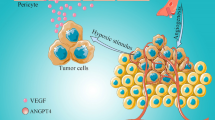Abstract
Recent evidence indicated that endocan may be a potential cell marker and a new target for cancers including acute leukemia since the serum endocan level in patients with acute leukemia was associated with the status of the disease, i.e., endocan was higly expressed in untreated acute leukemia, but decreased after chemotherapy and increased again during bone marrow regeneration. The present study showed that there was high level expression of endocan in cytoplasm of bone marrow blasts of patients with acute myeloid leukemia or acute lymphoblastic leukemia. The expression level of endocan was significantly decreased when the patients underwent remission after chemotherapy and re-bounces back when the acute leukemia relapsed. No obvious change in expression of endocan was observed before and after chemotherapy if the patients showed no remission after chemotherapy. (N-(4-Hydroxyphenyl) retinamide), a potent anti-angiogenic agent, could not only down-regulate the expression of vascular epithelial growth factor, but also decrease endocan transcription and expression in NB4 cells, a human acute promyelocytic leukemia cell line. These observations suggest that endocan could act as a predictor for the severity and the prognosis of acute leukemia. The findings could be used as the basis for future targeted therapy directed against bone marrow angiogenesis in acute leukemia treatment.




Similar content being viewed by others
References
Hatfield KJ, Olsnes AM, Gjertsen BT, Bruserud Ø (2005) Antiangiogenic therapy in acute myelogenous leukemia: targeting of vascular endothelial growth factor and interleukin 8 as possible antileukemic strategies. Curr Cancer Drug Targets 5:229–248
Lassalle P, Molet S, Janin A, Heyden JV, Tavernier J, Fiers W, Devos R, Tonnel AB (1996) ESM-1 is a novel human endothelial cell-specific molecule expressed in lung and regulated by cytokines. J Biol Chem 271:20458–20464
Sarrazin S, Adam E, Lyon M, Depontieu F, Motte V, Landolfi C, Lortat-Jacob H, Bechard D, Lassalle P, Delehedde M (2006) Endocan or endothelial cell specific molecule-1 (ESM-1): a potential novel endothelial cell marker and a new target for cancer therapy. Biochim Biophys Acta 1765:25–37
Hatfield KJ, Lassalle P, Leiva RA, Lindås R, Wendelboe Ø, Bruserud Ø (2011) Serum levels of endothelium-derived endocan are increased in patients with untreated acute myeloid leukemia. Hematology 16:351–356
Scherpereel A, Gentina T, Grigoriu B, Sénéchal S, Janin A, Tsicopoulos A, Plénat F, Béchard D, Tonnel AB, Lassalle P (2003) Overexpression of endocan induces tumor formation. Cancer Res 63:6084–6089
Aitkenhead M, Wang SJ, Nakatsu MN, Mestas J, Heard C, Hughes CC (2002) Identification of endothelial cell genes expressed in an in vitro model of angiogenesis: induction of ESM-1, (beta)ig-h3, and NrCAM. Microvasc Res 63:159–171
Ayala F, Dewar R, Kieran M, Kalluri R (2009) Contribution of bone microenvironment to leukemogenesis and leukemia progression. Leukemia 23:2233–2241
Hatfield K, Øyan AM, Ersvaer E, Kalland KH, Lassalle P, Gjertsen BT, Bruserud Ø (2009) Primary human acute myeloid leukaemia cells increase the proliferation of microvascular endothelial cells through the release of soluble mediators. Br J Haematol 144:53–68
Reikvam H, Hatfield KJ, Oyan AM, Kalland KH, Kittang AO, Bruserud O (2010) Primary human acute myelogenous leukemia cells release matrix metalloproteases and their inhibitors: release profile and pharmacological modulation. Eur J Haematol 84:239–251
Wegiel B, Ekberg J, Talasila KM, Jalili S, Persson JL (2009) The role of VEGF and a functional link between VEGF and p27Kip1 in acute myeloid leukemia. Leukemia 23:251–261
Li JL, Harris AL (2009) Crosstalk of VEGF and Notch pathways in tumour angiogenesis: therapeutic implications. Front Biosci 14:3094–3110
Thurston G, Kitajewski J (2008) VEGF and Delta-Notch: interacting signalling pathways in tumour angiogenesis. Br J Cancer 99:1204–1209
Zhang J, Ye J, Ma D, Liu N, Wu H, Yu S, Sun X, Tse W, Ji C (2013) Cross-talk between leukemic and endothelial cells promotes angiogenesis by VEGF activation of the Notch/Dll4 pathway. Carcinogenesis 34:667–677
Todorovic M, Radisavljevic Z, Balint B, Andjelic B, Todorovic V, Jovanovic MP, Mihaljevic B (2012) Increased angiogenesis-associated poor outcome in acute lymphoblastic leukemia: a single center study. Appl Immunohistochem Mol Morphol 20:488–493
Litwin C, Leong KG, Zapf R, Sutherland H, Naiman SC, Karsan A (2002) Role of the microenvironment in promoting angiogenesis in acute myeloid leukemia. Am J Hematol 70:22–30
Rennel E, Mellberg S, Dimberg A, Petersson L, Botling J, Ameur A, Westholm JO, Komorowski J, Lassalle P, Cross MJ, Gerwins P (2007) Endocan is a VEGF-A and PI3K regulated gene with increased expression in human renal cancer. Exp Cell Res 313:1285–1294
Reynolds CP, Maurer BJ, Kolesnick RN (2004) Ceramide synthesis and metabolism as a target for cancer therapy. Cancer Lett 206:169–180
O’Donnell PH, Guo WX, Reynolds CP, Maurer BJ (2002) N-(4-Hydroxyphenyl) retinamide increases ceramide and is cytotoxic to acute lymphoblastic leukemia cell lines, but not to non-malignant lymphocytes. Leukemia 16:902–910
Faderl S, Lotan R, Kantarjian HM, Harris D, Van Q, Estrov Z (2003) N-(4-Hydroxylphenyl)retinamide (fenretinide, 4-HPR), a retinoid compound with antileukemic and proapoptotic activity in acute lymphoblastic leukemia (ALL). Leuk Res 27:259–266
Delia D, Aiello A, Lombardi L, Pelicci PG, Grignani F, Grignani F, Formelli F, Menard S, Costa A, Veronesi U (1993) N-(4-Hydroxyphenyl) retinamide induces apoptosis of malignant hemopoietic cell lines including those unresponsive to retinoic acid. Cancer Res 53:6036–6041
Sogno I, Venè R, Sapienza C, Ferrari N, Tosetti F, Albini A (2009) Anti-angiogenic properties of chemopreventive drugs: fenretinide as a prototype. Rec Results Cancer Res 181:71–76
Acknowledgments
We thank Professor Chen Feihu for kindly providing 4-HPR used in this study. This study was supported by the Fund for Young Talents in College of Anhui Province (No. 2012SQRL067), National Natural Science Foundation of China (No. 81201907), National Natural Science Foundation of China (No. 81272399), Research Fund for Doctor in Anhui Medical University (XJ201229).
Author information
Authors and Affiliations
Corresponding author
Additional information
Zhe Xu and Sumei Zhang have contributed equally to this work.
Rights and permissions
About this article
Cite this article
Xu, Z., Zhang, S., Zhou, Q. et al. Endocan, a potential prognostic and diagnostic biomarker of acute leukemia. Mol Cell Biochem 395, 117–123 (2014). https://doi.org/10.1007/s11010-014-2117-0
Received:
Accepted:
Published:
Issue Date:
DOI: https://doi.org/10.1007/s11010-014-2117-0




